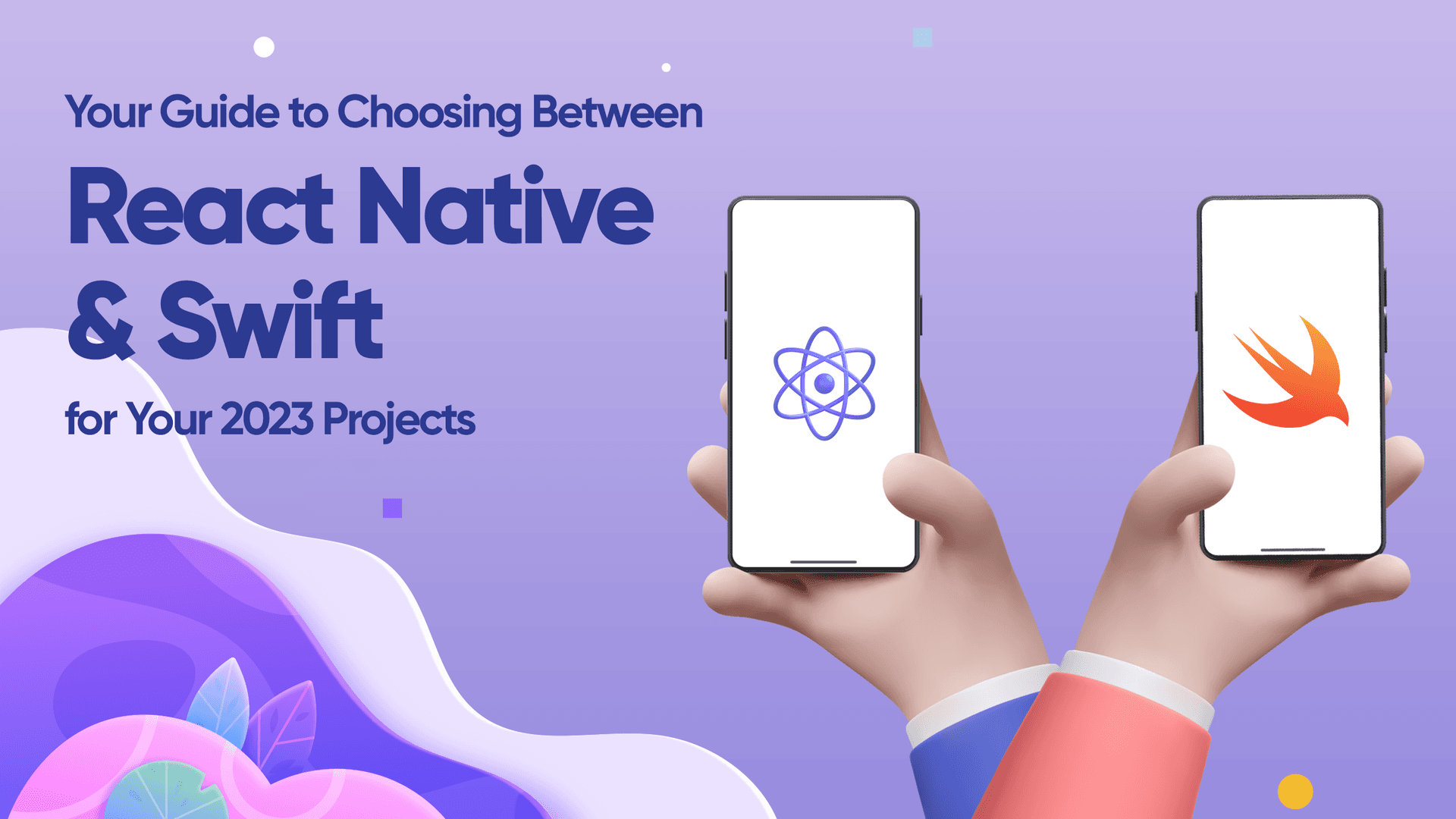Your Guide to Choosing Between React Native and Swift for Your 2023 Projects

Quick Summary: With a mobile market that seems to be constantly expanding, companies are looking for ways to create sleeker, more innovative applications than ever before. Although it may be surprising that Android controls the majority of the market share with 73%, the App Store actually has almost 1.5 times more apps than Google Play. However, the real question is, why do so many companies prefer developing apps for iOS devices?
What is Swift?
In 2014, Apple released Swift – a sleek, modern programming language that’s specifically designed to create native iOS applications for Apple devices. Not only is it maintained by an open-source community, but Swift offers developers a multi-paradigm and general-purpose language that’s ideal for creating apps for watchOS, macOS, tvOS, and other Apple-powered platforms.
With its concise and expressive syntax, Swift has quickly become a go-to programming interface that’s both interactive and easy to use. It was even designed to replace Objective-C, ensuring that it’s a seamless and practical way to create iOS applications.
Popular Apps Built Using Swift
The most impressive and widely-known applications are created with one of the most popular programming languages out there: Swift. We’ve curated a list of top-performing apps that will enhance your understanding of what makes them stand out from the rest.
- Airbnb
- Lyft
- SlideShare
- Test Center

Benefits of Swift
- Better Error Handling
Swift has robust typing, which gives it an edge over other programming languages. Swift programs can handle errors without crashing the application gracefully. It’s faster, more reliable, and offers a better developer experience compared to other programming languages.
- Easy to Scale
Swift is a programming language that stands the test of time and enables developers to easily implement new features easily, making it ideal for future-proofing projects. This versatility makes it easier to scale apps than with React Native.
- Readability
The syntax of the language is simpler and easier to grasp, which makes it a more readable technology when compared to others. The reduced lines of code are a major benefit, allowing developers to shorten the time-to-market for their application without sacrificing its quality.
- User experience
Swift is a new programming language that was built with native iOS development in mind. By using this language, developers get more control over the device’s features and can access what the OS itself has to offer. As a result, Swift apps will look and perform better than your average app written in Objective-C.
What is React Native?
React Native is an innovative tool created by the Facebook team to speed up the development of mobile applications. What makes it even more impressive is that it allows developers to build apps across various platforms, which means less work and more efficiency. Another exciting aspect of React Native is its compatibility with JavaScript, the world’s most popular programming language. With an overwhelming amount of developer support, JavaScript is being used by almost 68% of all developers. While building platform-independent apps may save time and resources, they usually lack power and have a subpar user experience. So, let’s dive deeper into React Native’s pros and cons before comparing it to the Swift programming language.
Popular Apps Built Using React Native
Curious about the cost of building a React Native app? Our blog has some helpful insights! And if you need some inspiration, check out these amazing apps that were built using React Native.
- Walmart
- Bloomberg
- SoundCloud

Benefits of React Native
- Time efficiency
React Native is a technology that can help reduce development time significantly. What’s even better is that it’s an operating system independent! This means that instead of writing separate code for different platforms, developers can write one code and deploy it to both platforms with just a few tweaks. This simplifies the entire process and helps get products to market faster.
- Hot Reloading
React Native’s hot reloading feature lets developers see their code come to life in real time. This means they can work more efficiently and make changes quickly without having to constantly refresh their app. With this innovative feature, development becomes a more engaging and creative experience, allowing developers to bring their vision to life with ease.
- Flawless Performance
Native apps are specifically designed for a certain operating system, allowing them to fully utilize the device’s processing capabilities for top-notch performance. With seamless operation and minimal errors, these apps are incredibly user-friendly.
- Easy to Integrate
With native app integration, the possibilities are endless! GPS, a Camera, and a touchscreen come standard, and complex features such as VR, AI, IoT, and AR can be smoothly implemented. Building onto a native app provides a seamless and innovative way to bring various devices and features into the mix. The future is now!
Detailed Comparison: Swift vs React Native
- React Native vs Swift: Performance
When it comes to performance, the showdown between React Native and Swift is no easy feat. While React Native has the upper hand when it comes to memory usage and GPU speed during testing, Swift excels in terms of CPU consumption. However, developers using React Native have the advantage of seamlessly embedding native codes and utilizing a range of tools for various tasks. Ultimately, when it comes to performance, React Native comes out victorious over Swift
- Swift vs React Native: User Interface
Swift and React Native are both popular platforms for iOS app development. While Swift offers a sleek and visually appealing UI, React Native relies on JavaScript libraries to create platform-centric components that provide a native-like experience. However, staying up-to-date with changes and advancements in the native environment can be a challenge for React Native developers.
- React Native vs Swift: Stability
When it comes to building native applications, Swift reigns supreme over React Native. Swift has the potential to harness every possibility available on the platform, while React Native focuses more on utilizing internal APIs and libraries. This approach can make the development process a bit unstable and less reliable. Additionally, Swift surpasses React Native in handling heavy tasks and visual effects, making it a more stable and dependable option for iOS development.
- Swift vs React Native: Learning Curve
When it comes to React Native for iOS app development, developers often find the process to be simple and straightforward. However, the process differs from web development, leaving some developers feeling out of their element. Luckily, React Native provides detailed documentation and an extensive library to assist developers in learning the language with ease.
On the other hand, Swift has a more complex learning curve, but Apple has stepped in to assist with an official document that explains the language’s fundamentals and features. Additionally, professionals with no technical background can utilize Swift Playgrounds to learn with ease. With these resources at your fingertips, mastering these languages and creating stunning iOS apps is entirely achievable.
When Should I Use React Native?
Swift is the gold standard for businesses looking to create apps with exceptional memory management and sleek user interfaces. It’s the perfect pick for native iOS development that can easily be extended to other Apple gadgets, including laptops, tablets, TVs, and wearables. With Swift, the possibilities are endless, and the results are nothing short of impressive.
When Should I Use Swift?
React Native is the go-to choice for companies in need of a speedy MVP or prototype. Its streamlined approach to app development reduces coding time, allowing for swift deployment on both iOS and Android devices. For businesses on a tight schedule, React Native offers an affordable solution that doesn’t skimp on quality. Despite its simplicity, React Native can also handle complex projects; however, it’s important to note that this system may not offer all the bells and whistles that come with using device features such as Bluetooth or camera technology. A PHP Web Development Company may also consider React Native for hybrid app development, especially when looking to complement their web solutions with a mobile counterpart.
Conclusion
Deciding between React Native and Swift for your app development is no easy feat. With so many factors to consider, it can be quite a daunting task. However, fear not! Brain Inventory React native app development company is here to help. Whether it’s project duration, budget, or even personal preference, our experts have got you covered. If you’re looking to build a high-performance dynamic app with complex graphic effects, Swift is the way to go. But if you have developers who are well-versed in JavaScript, React Native might prove to be the better choice. Regardless of which path you choose, we’re always available to lend a helping hand. Contact us today to learn more!

Have an idea?
Get in touch, we’d be
happy to hear from you
We are always looking out for new collaborations, whether you are a client who is passionate about a project or a talent who is interested in joining our team, our doors are always open.
locate us

India (HQ)
618, Shekhar Central, Palasia Square, A.B Road, Indore, Madhya Pradesh, 452001
+918109561401

United Kingdom
Brain Inventory, SBVS, 8 Roundhay Road, Leeds, UK, LS7 1AB
+18008209286

Canada
44 Main Street East Milton, ONCanada L9T 1N3
+4166696505

Jordan
185 Wasfi Al-Tal Street, Ammon Oasis Complex P.O Box 4724 Amman 11953 Jordan
+960770781000

USA
720 Seneca St Ste 107 Seattle, USA 98101
+1(206)6533419
if it's digital,we'll make it.
- Numetric - Online Accounting Software similar to QuickBooks
- Bloomia - Kegel exercise
- Virifi - Blockchain Powered Document Certification & Signing Platform
- Revolution Travel CRM - Custom CRM Built for Travel Agents
- Fatoura - Online Invoicing Platform
- My Fit Mantra - Your health partner
- Ocureel - Relation Building and video sharing Application